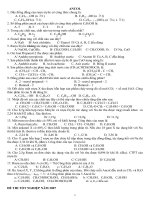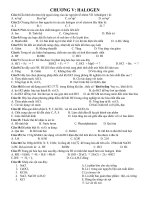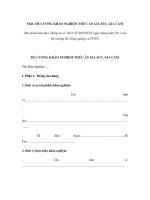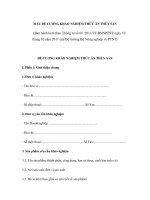Đề cương trắc nghiệm Hành Vi Tổ Chức (Organizational Behavior) CHƯƠNG 2
Bạn đang xem bản rút gọn của tài liệu. Xem và tải ngay bản đầy đủ của tài liệu tại đây (39.55 KB, 11 trang )
Chapter 2: Individual Behaviour and
Learning in Organizations
2-1. Direction, intensity, and persistence are three dimensions
of:
a.
Motivation
b.
Organizational citizenship.
c.
Role perceptions
d.
Person-job matching
e.
ability
2-2. Which of the following is not explicitly stated in the model
of individual behaviour and performance?
a.
Motivation
b.
Self-efficacy
c.
Role perceptions
d.
Situational factors
e.
Ability
2-3. The president of ABC Corp. wants more organizational
citizenship in the company. The president is basically saying
that:
a. the organization needs to identify itself more with its
home country rather than act as a "global entity".
b. employees need to spend more time helping
coworkers.
c. the organization needs to take on more obligations to
help society.
d. employees should have the right to elect their
supervisor.
e.
none of the above.
2-4. Ability includes which of these?
a.
Direction and intensity
b.
Natural aptitude and intensity
c.
Persistence and direction
d.
Intensity and learned capabilities
e.
Natural aptitude and learned capabilities
2-5. A person's beliefs about what behaviours are appropriate or
necessary in a particular situation are called:
a.
Task performance
b.
Natural aptitudes
c.
Role perceptions
d.
Situational factors
e.
Competencies
2-6. Goal-directed activities under the individual's control are
known as:
a.
Learning
b.
Tacit knowledge
c.
Self-efficacy
d.
Task performance
e.
Organizational citizenship
2-7. Absenteeism is caused by which of these elements in the
MARS model?
a.
Motivation
b.
Ability
c.
Situational factors
d.
All of the above
e.
Only 'a' and 'c' affect absenteeism.
2-8. Tacit knowledge is mainly acquired:
a.
through observation and direct experience.
b.
through natural aptitude.
c.
through lectures and reading.
d.
by writing a series of final examinations
e.
genetically.
2-9. Which of the following says that the likelihood that an
operant behaviour will be repeated depends on its consequences.
a.
Organizational citizenship
b.
Law of effect
c.
Action learning theory
d.
MARS model
e.
Tacit knowledge
2-10. Behaviour modification mainly focuses on:
a. the environmental contingencies that precede and
follow behaviour.
b.
ways to increase tacit knowledge.
c.
ways to make employees happier in their jobs.
d.
ways to change employee attitudes.
e.
the process of action learning.
2-11. You make more follow-up calls to clients because your
boss stops bothering you when s/he sees you talking with
clients. This is an example of:
a.
negative reinforcement.
b.
punishment.
c.
positive reinforcement.
d.
tacit learning.
e.
extinction.
2-12. Promotions typically follow which of these schedules?
a.
variable interval
b.
fixed interval
c.
fixed ratio
d.
variable ratio
e.
variable ratio
2-13. One problem with behaviour modification is that it:
a. encourages punishment more than positive
reinforcement.
b.
Ignores the timing or scheduling or reinforcement.
c.
Is often viewed as a form of manipulation.
d. Ignores possibility that feedback improves employee
learning.
e. Rarely improves task performance or learning in real
organizations.
2-14. Feedback from nonsocial sources is generally better than
social sources when employees:
a.
expect to receive negative feedback.
b.
want accurate information about their job performance
c. Want to receive information quickly without
evaluation from others.
d.
All of the above
e.
None of the above.
2-15. Social learning theory explicitly includes which of the
following concepts?
a.
Behavioural modelling
b.
Absorptive capacity
c.
Action learning
d.
Variable ratio scale
e.
MARS model
True or False
2-1. The four elements of the MARS model are motivation,
attitudes, relationships, and situational factors.
True
False
2-2. Intensity refers to the fact that motivation is goal-oriented,
not random.
True
False
2-3. Person-job matching includes the strategy of training
employees with competencies required for the required task.
True
False
2-4. Situational factors are conditions beyond the employee's
immediate control, at least in the short-term, which constrain or
facilitate his/her behaviour and performance.
True
False
2-5. Most knowledge in organizations is explicit rather than
tacit.
True
False
2-6. Behaviour modification emphasizes involuntary behaviours.
True
False
2-7. The law of effect refers to a permanent change in behaviour
that occurs as a result of a person's interaction with the
environment.
True
False
2-8. Negative reinforcement is sometimes called avoidance
learning.
True
False
2-9. A piece-rate system where employees get paid after they
produce a fixed number of units is said to be following the fixed
interval schedule
True
False
2-10. Behaviour modification programs often suffer from
"reward inflation," in which the reinforcer either is quickly
forgotten or is eventually considered an entitlement.
True
False
2-11. 360-degree feedback works best when the results are used
for determining pay bonuses, not just employee development.
True
False
2-12. Self-reinforcement occurs whenever an employee has
control over a reinforcer but doesn't "take" the reinforcer until
completing a self-set goal.
True
False
2-13. Action learning occurs when we acquire information about
relationships in the environment without any conscious attempt
to do so.
True
False









